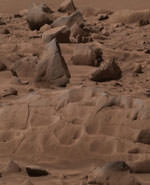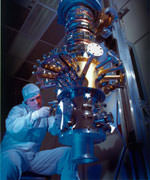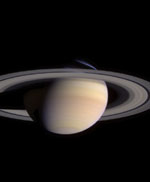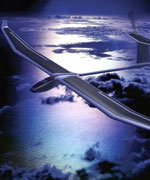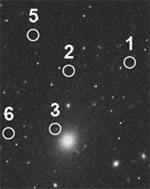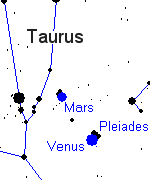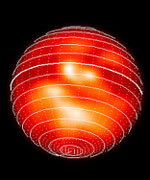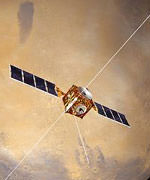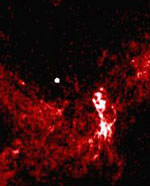
Image credit: NRAO
Thirty years after astronomers discovered the mysterious object at the exact center of our Milky Way Galaxy, an international team of scientists has finally succeeded in directly measuring the size of that object, which surrounds a black hole nearly four million times more massive than the Sun. This is the closest telescopic approach to a black hole so far and puts a major frontier of astrophysics within reach of future observations. The scientists used the National Science Foundation’s Very Long Baseline Array (VLBA) radio telescope to make the breakthrough.
“This is a big step forward,” said Geoffrey Bower, of the University of California-Berkeley. “This is something that people have wanted to do for 30 years,” since the Galactic center object, called Sagittarius A* (pronounced “A-star”), was discovered in 1974. The astronomers reported their research in the April 1 edition of Science Express.
“Now we have a size for the object, but the mystery about its exact nature still remains,” Bower added. The next step, he explained, is to learn its shape, “so we can tell if it is jets, a thin disk, or a spherical cloud.”
The Milky Way’s center, 26,000 light-years from Earth, is obscured by dust, so visible-light telescopes cannot study the object. While radio waves from the Galaxy’s central region can penetrate the dust, they are scattered by turbulent charged plasma in the space along the line of sight to Earth. This scattering had frustrated earlier attempts to measure the size of the central object, just as fog blurs the glare of distant lighthouses.
“After 30 years, radio telescopes finally have lifted the fog and we can see what is going on,” said Heino Falcke, of the Westerbork Radio Observatory in the Netherlands, another member of the research team.
The bright, radio-emitting object would fit neatly just inside the path of the Earth’s orbit around the Sun, the astronomers said. The black hole itself, they calculate, is about 14 million miles across, and would fit easily inside the orbit of Mercury. Black holes are concentrations of matter so dense that not even light can escape their powerful gravity.
The new VLBA observations provided astronomers their best look yet at a black hole system. “We are much closer to seeing the effects of a black hole on its environment here than anywhere else,” Bower said.
The Milky Way’s central black hole, like its more-massive cousins in more-active galactic nuclei, is believed to be drawing in material from its surroundings, and in the process powering the emission of the radio waves. While the new VLBA observations have not provided a final answer on the nature of this process, they have helped rule out some theories, Bower said. Based on the latest work, he explained, the top remaining theories for the nature of the radio- emitting object are jets of subatomic particles, similar to those seen in radio galaxies; and some theories involving matter being accelerated near the edge of the black hole.
As the astronomers studied Sagittarius A* at higher and higher radio frequencies, the apparent size of the object became smaller. This fact, too, Bower said, helped rule out some ideas of the object’s nature. The decrease in observed size with increasing frequency, or shorter wavelength, also gives the astronomers a tantalizing target.
“We think we can eventually observe at short enough wavelengths that we will see a cutoff when we reach the size of the black hole itself,” Bower said. In addition, he said, “in future observations, we hope to see a ‘shadow’ cast by a gravitational lensing effect of the very strong gravity of the black hole.”
In 2000, Falcke and his colleagues proposed such an observation on theoretical grounds, and it now seems feasible. “Imaging the shadow of the black hole’s event horizon is now within our reach, if we work hard enough in the coming years,” Falcke added.
Another conclusion the scientists reached is that “the total mass of the black hole is very concentrated,” according to Bower. The new VLBA observations provide, he said, the “most precise localization of the mass of a supermassive black hole ever.” The precision of these observations allows the scientists to say that a mass of at least 40,000 Suns has to reside in a space corresponding to the size of the Earth’s orbit. However, that figure represents only a lower limit on the mass. Most likely, the scientists believe, all the black hole’s mass — equal to four million Suns — is concentrated well inside the area engulfed by the radio-emitting object.
To make their measurement, the astronomers had to go to painstaking lengths to circumvent the scattering effect of the plasma “fog” between Sagittarius A* and Earth. “We had to push our technique really hard,” Bower said.
Bower likened the task to “trying to see your yellow rubber duckie through the frosted glass of the shower stall.” By making many observations, only keeping the highest-quality data, and mathematically removing the scattering effect of the plasma, the scientists succeeded in making the first-ever measurement of Sagittarius A*’s size.
In addition to Bower and Falcke, the research team includes Robin Herrnstein of Columbia University, Jun-Hui Zhao of the Harvard-Smithsonian Center for Astrophysics, Miller Goss of the National Radio Astronomy Observatory, and Donald Backer of the University of California-Berkeley. Falcke also is an adjunct professor at the University of Nijmegen and a visiting scientist at the Max-Planck Institute for Radioastronomy in Bonn, Germany.
Sagittarius A* was discovered in February of 1974 by Bruce Balick, now at the University of Washington, and Robert Brown, now director of the National Astronomy and Ionospheric Center at Cornell University. It has been shown conclusively to be the center of the Milky Way, around which the rest of the Galaxy rotates. In 1999, Mark Reid of the Harvard-Smithsonian Center for Astrophysics and his colleagues used VLBA observations of Sagittarius A* to detect the Earth’s motion in orbit around the Galaxy’s center and determined that our Solar System takes 226 million years to make one circuit around the Galaxy.
In March 2004, 55 astronomers gathered at the National Radio Astronomy Observatory facility in Green Bank, West Virginia, for a scientific conference celebrating the discovery of Sagittarius A* at Green Bank 30 years ago. At this conference, the scientists unveiled a commemorative plaque on one of the discovery telescopes.
The Very Long Baseline Array, part of the National Radio Astronomy Observatory, is a continent-wide radio-telescope system, with 10, 240-ton dish antennas ranging from Hawaii to the Caribbean. It provides the greatest resolving power, or ability to see fine detail, of any telescope in astronomy, on Earth or in space.
The National Radio Astronomy Observatory is a facility of the National Science Foundation, operated under cooperative agreement by Associated Universities, Inc.
Original Source: NRAO News Release

